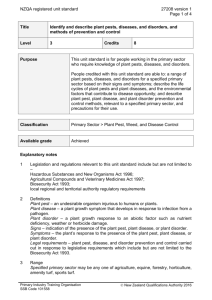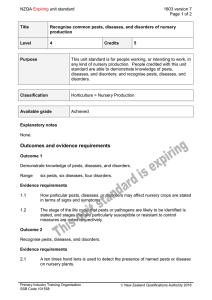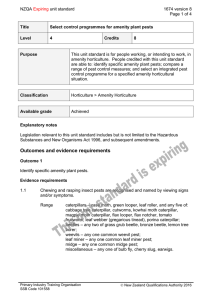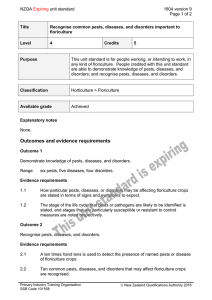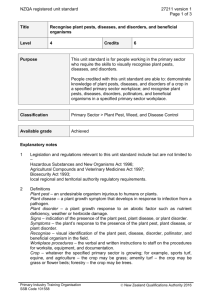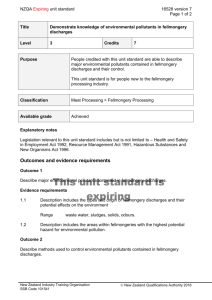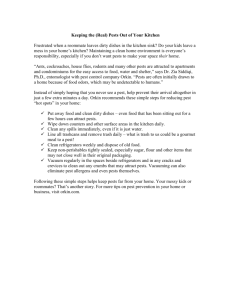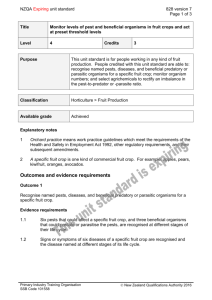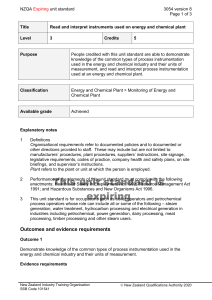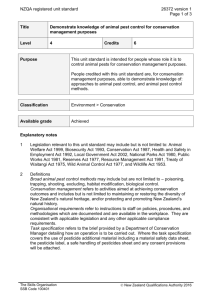21557 Identify plant pests, diseases, and disorders, and
advertisement
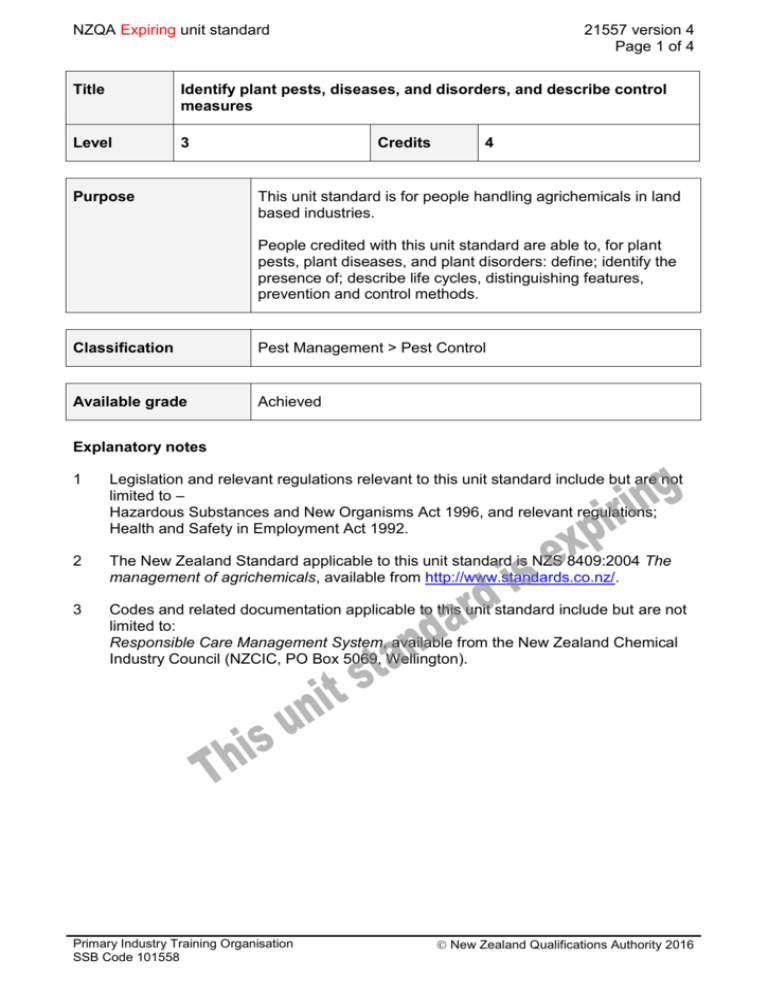
NZQA Expiring unit standard 21557 version 4 Page 1 of 4 Title Identify plant pests, diseases, and disorders, and describe control measures Level 3 Purpose Credits 4 This unit standard is for people handling agrichemicals in land based industries. People credited with this unit standard are able to, for plant pests, plant diseases, and plant disorders: define; identify the presence of; describe life cycles, distinguishing features, prevention and control methods. Classification Pest Management > Pest Control Available grade Achieved Explanatory notes 1 Legislation and relevant regulations relevant to this unit standard include but are not limited to – Hazardous Substances and New Organisms Act 1996, and relevant regulations; Health and Safety in Employment Act 1992. 2 The New Zealand Standard applicable to this unit standard is NZS 8409:2004 The management of agrichemicals, available from http://www.standards.co.nz/. 3 Codes and related documentation applicable to this unit standard include but are not limited to: Responsible Care Management System, available from the New Zealand Chemical Industry Council (NZCIC, PO Box 5069, Wellington). Primary Industry Training Organisation SSB Code 101558 New Zealand Qualifications Authority 2016 NZQA Expiring unit standard 21557 version 4 Page 2 of 4 4 Definitions agrichemical – any substance, whether inorganic or organic, man-made or naturally occurring, modified or in its original state, that is used in any agriculture, horticulture or related activity, to eradicate, modify or control flora and fauna. It includes agricultural compounds, fertilisers, vertebrate pest control products and oral nutrition products (this definition differs to that in NZS 8409:2004, where agrichemicals exclude fertilisers, vertebrate pest control products and oral nutrition products); plant pest – an undesirable organism injurious to humans or plants; plant disease – a plant growth symptom that develops in response to infection from a pathogen; plant disorder – a plant growth response to an abiotic factor such as nutrient deficiency, weather or herbicide damage; signs – indication of the presence of the plant pest, plant disease, or plant disorder; symptoms – the plant’s response to the presence of the plant pest, plant disease, or plant disorder; legal – a weed prevention and control method carried out in response to legislative requirements which includes but is not limited to the Biosecurity Act 1993. 5 Assessment identification of the presence of plant pests, plant diseases, and plant disorders does not include laboratory analysis. Outcomes and evidence requirements Outcome 1 Define, and identify the presence of plant pests, plant diseases, and plant disorders. Evidence requirements 1.1 The terms plant pest, plant disease, and plant disorder are defined in relation to a specified land based industry. 1.2 The presence of plant pests, plant diseases, and plant disorders are identified by their signs, and visible symptoms. Range evidence is required for at least three plant pests, three plant diseases, and three plant disorders. Outcome 2 Describe the life cycles of plant pests and plant diseases, and the distinguishing features of plant pests, plant diseases, and plant disorders. Evidence requirements 2.1 Stages in plant pest, and plant disease life cycles are described in sequence, and the signs, and symptoms of each stage are described in terms of plant damage. Range evidence is required for at least two different insect life cycles, and two diseases life cycles. Primary Industry Training Organisation SSB Code 101558 New Zealand Qualifications Authority 2016 NZQA Expiring unit standard 2.2 21557 version 4 Page 3 of 4 Plant pests, plant diseases, and plant disorders are distinguished by their signs, and symptoms. Range evidence is required for at least four plant pests, three plant diseases, and two plant disorders. Outcome 3 Describe plant pest, plant disease, and plant disorder prevention and control methods. Range biological, physical, cultural, chemical, legal, integrated pest management (IPM). Evidence requirements 3.1 Prevention and control methods are described in terms of their advantages and disadvantages. 3.2 Prevention and control methods are described in terms of their suitability for a specified land based industry. This unit standard is expiring. Assessment against the standard must take place by the last date for assessment set out below. Status information and last date for assessment for superseded versions Process Version Date Last Date for Assessment Registration 1 27 May 2005 31 December 2015 Review 2 18 August 2011 31 December 2015 Rollover 3 17 October 2013 31 December 2015 Rollover 4 17 September 2015 31 December 2019 Consent and Moderation Requirements (CMR) reference 0052 This CMR can be accessed at http://www.nzqa.govt.nz/framework/search/index.do. Please note Providers must be granted consent to assess against standards (accredited) by NZQA, before they can report credits from assessment against unit standards or deliver courses of study leading to that assessment. Industry Training Organisations must be granted consent to assess against standards by NZQA before they can register credits from assessment against unit standards. Providers and Industry Training Organisations, which have been granted consent and which are assessing against unit standards must engage with the moderation system that applies to those standards. Primary Industry Training Organisation SSB Code 101558 New Zealand Qualifications Authority 2016 NZQA Expiring unit standard 21557 version 4 Page 4 of 4 Requirements for consent to assess and an outline of the moderation system that applies to this standard are outlined in the Consent and Moderation Requirements (CMR). The CMR also includes useful information about special requirements for organisations wishing to develop education and training programmes, such as minimum qualifications for tutors and assessors, and special resource requirements. Primary Industry Training Organisation SSB Code 101558 New Zealand Qualifications Authority 2016
